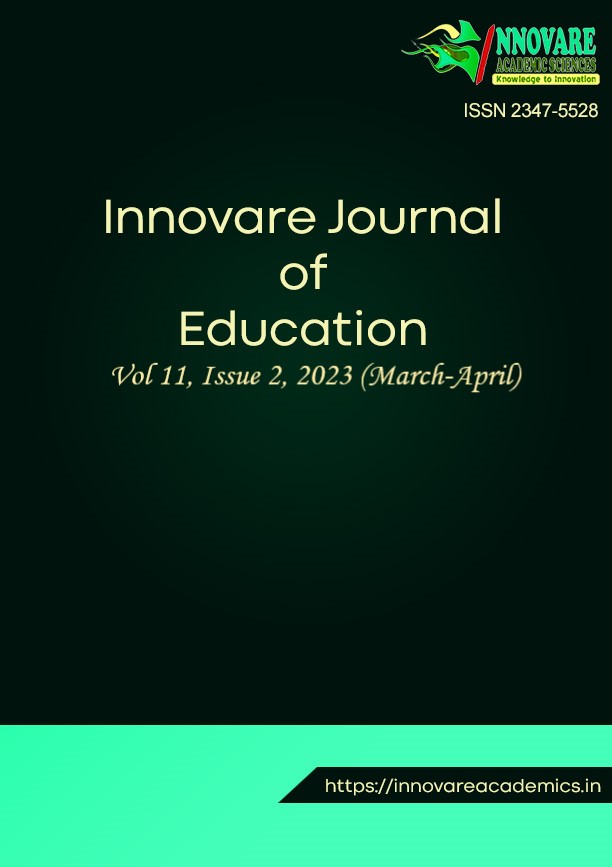USE OF HIGHLIGHTING STRATEGIES IN READING COMPREHENSION AND EFFECTS ON ATTAINMENT IN SELECTED READING SKILLS
DOI:
https://doi.org/10.22159/ijoe.2023v11i2.47016Keywords:
language strategies, highlighting, reading comprehension, reading skills, skimming, scanningAbstract
This study had two specific research objectives, two research questions and four specific research hypotheses. The study used quasi-experimental research designs. Data were collected using a standardized test. The study had a population of English Language students from secondary schools. The purposive sampling technique was used. The sample consisted of 40 students. The reliability of the instruments was established using Cronbach Alpha, which yielded a reliability coefficient of .70. Data collected were analyzed using the Statistical Package for Social Sciences (SPSS version 24.00). Findings revealed that reading comprehension performances of students taught skimming and scanning in the highlighting strategies were significantly higher than those who were not taught using the highlighting strategies.
Downloads
References
Acevedo, C., & Rose, D. (2007). Learning to read, reading to learn – A middle years literacy intervention project [Annual review]. International Journal of Learning: Annual Review, 12(11), 73–84. https://doi.org/10.18848/1447-9494/CGP/v13i11/45095
Akyol, H., Çakiroğlu, A., & Kuruyer, H. G. (2014). A study on the development of reading skills of the students having difficulty in reading: Enrichment reading program. International Electronic Journal of Elementary Education, 6(2), 199–212. https://files.eric.ed.gov/fulltext/EJ1053627.pdf
Anchimbe, E. (2005). Anglophonism and francophonism: The stakes of (official) language identity in Cameroon. https://hal.univ-reunion.fr/hal-02344078/file/ALIZES25-26-Anchimbe.pdf
Anderson, K. L., Scanlon, D. M., & Sweeny, J. M. (2010). Early intervention for reading difficulties: The interactive strategies. Guilford Press.
Andi, A. (2015). The effectiveness of skimming-scanning strategy in improving students reading comprehension at the second grade of SMK Darussalam Makassar. ETERNAL (English, Teaching, Learning, and Research Journal), I(01), 69–83.
Ben-Yehudah, G., & Eshet-Alkalai, Y. (2018). The contribution of text-highlighting to comprehension: A comparison of print and digital reading. Journal of Educational Multimedia and Hypermedia, 27(2), 153–178. https://eric.ed.gov/?id=EJ1174335
Briner, M. (1999). What is constructivism? University of Colorado at Denver School of Education.
Brown, H. D. (2001). Teaching by principles: An interactive approach to language pedagogy (2nd ed.). Longman.
Brown, H. D. (2007). Language assessment principles and classroom practice. Pearson Education, Inc.
Cameroon General Certificate of Education Board. (2016). GCE O/L English language syllabus. Cameroon General Certificate of Education Board.
Carrell, P. L. (1998). Can reading strategies be successfully taught? Australian Review of Applied Linguistics, 21(1), 1–20. https://eric.ed.gov/?id=EJ579696. https://doi.org/10.1075/aral.21.1.01car
Cerveny, C. G., & LaCotti, M. L. (2003). 35 Learning tools for practicing essential reading and writing strategies. Education Review. http://dx.doi.org/10.14507/er.v0.344
Dechant, E. (1991). Understanding and teaching reading: An interactive model. Lawrence Erlbaum.
Deponio, P., & Macintyre, C. (2003). Identifying and supporting children with specific learning difficulties: Looking beyond the label to assess the whole child. RoutledgeFalmer.
EpiData Association. (2008). Odense den Mark. EpiTour – An introduction to EpiData Entry. http://www.epidata.dk
Erekson, J. A., Opitz, M. F., & Rubin, D. (2011). Reading diagnosis and improvement assessment and instruction. Pearson.
Gibbons, P. (2002). Scaffolding language scaffolding learning: Teaching second language learners in the mainstream classroom. Heinemann.
Grellet, F. (1987). Developing reading skills. Cambridge University Press.
Hancock, J., & Leaver. C. (2006). Teaching strategies for literacy. Australian Literacy Educators’ Association.
Harmer, J. (2005). How to teach English. An introduction to the practice of English language teaching. Addision Weserly Longman Limited.
Harris, A. J., & Sipay, E. R. (1990). How to increase reading ability: A guide to developmental and remedial methods (9th ed.). Longman.
Harvey, S., & Goudvis, A. (2007). Strategies that work: Teaching comprehension for understanding and engagement (2nd ed.). Stenhouse Publishers.
Hedgcock, J. S., & Ferris, D. R. (2009). Teaching Readers of English: Students, texts, and contexts. Routledge.
Hood, S., & Forey, G. (2005). Introducing a conference paper: Getting interpersonal with your audience. Journal of English for Academic Purposes, 4(4), 291–306. https://doi.org/10.1016/j.jeap.2005.07.003
Kamhi, A., & Catts, H. (2008). The language basis of reading: Implications of classification and treatment of children with reading disabilities. In K. Bulter & E. Silliman (Eds.), Speaking, reading, and writing in children with language and learning disabilities: New paradigms in research and practice. New paradigms in research and practice. Erlbaum.
Kuchah, H. K. (2013). Context-appropriate ELT pedagogy: An investigation in Cameroonian primary schools [Unpublished doctoral thesis]. University of Warwick.
Loucky, J. P. (1996). Combining intensive and extensive reading strategies with cooperative and communicative learning Activities.
Murad, I. H. (2014). Investigating Kurdish students’ reading strategies. Education, 4(6), 135–141. https://doi.org/10.5923/j.edu.20140406.01
Naiken, D. J. (2016). Reading difficulties as barriers to learning experienced by learners entering the intermediate phase [Unpublished master’s dissertation]. University of South Africa.
Nunan, D. (2003). Practical English language teaching. McGraw-Hill.
Nuttal, C. (1996). Teaching reading skill in a foreign language. Oxford University Press.
Oxford, R. L. (1990). Language learning strategies: What every teacher should know. Newbery House Publishers.
Ruddell, R. B., R. B., & Unrau, N. (2004). Theoretical models and processes of reading. International Reading Association.
Schumm, J. S. (2006). Reading assessment and instruction for all learners. New York.
Seyler, D. U. (2004). Read, reason, write: An argument text and reader. Mcgraw-Hill College.
Tante, A. C. (2018). I can talk about a lot of things in the other language but not in English’: Teaching speaking skills in Cameroon primary schools. In A. Burns & J. Siegel (Eds.), International Perspectives on Teaching the Four Skills in ELT Listening (pp. 81–96). Palgrave Macmillan Cham. https://doi.org/10.1007/978-3-319-63444-9
Thorndyke, P. W., & Hayes-Roth, B. (1979). The use of schemata in the acquisition and transfer of knowledge. Cognitive Psychology, 11(1), 82–106. https://doi.org/10.1016/0010-0285(79)90005-7
United Nations Educational, Scientific and Cultural Organization. (2011). UNESCO statistical report. Paris.
Vygotsky, L. S. (1978). Mind in society. Harvard University Press.
Wallace. (1992). Critical literacy awareness in the EFL classroom. In N. Fairclough (Ed.), Critical language awareness (pp. 59-92). Routledge.
Yik, N. C., Yi, L. X., Somadam, S. T. N., Ezwan, A., Amirudin, B., & Anantha, S. (2019). Effect of highlighting text on concentration, memory and attention among undergraduate medical students: A randomized controlled trial. American Journal of Educational Science, 4(4), 149–158.
Published
How to Cite
Issue
Section
Copyright (c) 2023 ACHU TANTE, ENANGA

This work is licensed under a Creative Commons Attribution 4.0 International License.





